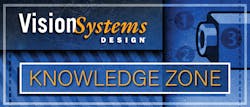Components of a machine vision system
There are well over 450 manufacturers and suppliers globally with diverse product offerings of machine vision system components. This can present a real challenge for someone new to machine vision who is trying to understand exactly what is available, why these components exist, and what role each component plays in a machine vision system.
Component differentiation is sometimes unclear, which presents a challenge for choosing the best components for a machine vision or image processing application. To help, Vision Systems Design publishes our annual Buyer’s Guide.
To gain a high-level understanding of the types of components that go into developing a machine vision system, regardless of the specific type of platform you’re building or the type of application you are trying to solve, we can break down the parts of a typical, PC-based, general purpose machine vision system.
A typical PC-based machine vision system includes a light that illuminates the subject to enhance the contrast of the features of interest. A lens focuses the incoming light reflected off the object of interest onto an image sensor housed inside the camera that along with electronics captures and digitizes an image. The image data is then sent through cables to the PC.
Depending on the type of camera being used, the machine vision system may require a frame grabber. Software that typically runs on the PC processes and analyzes the acquired data to generate information, such as whether or not a part is defective.
Finally, the resulting data is communicated to the outside world, typically using standard factory automation communication protocols. In the case of an industrial application we may have communications with a robot controller or programmable logic controller (PLC) that handles all the inputs from factory automation components such as proximity sensors, emergency stop switches, photoelectric sensors and encoders, as well as outputs that might go to devices such as status indicators and tower lights.


